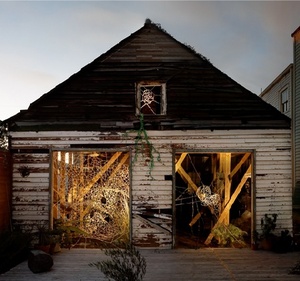This is an archive of the ArtCat Zine, 2007-2009. Please visit our new project, IDIOM.
KKProjects In New Orleans
Earlier this spring I had the pleasure of touring New Orleans with two art and architecture historians from Tulane University. We of course spent a significant amount of time wandering the Lower 9th Ward, gawking at the rescue hieroglyphics spray painted on abandoned houses, and generally participating in what seems to be the booming industry of trauma tourism. But we also found time for art. In particular, we spent part of one afternoon with KKProjects, an exhibition space composed of six previously abandoned houses in the St. Roch neighborhood.
Founded by Kirsha Kaechele, KKProjects offers each of its spaces for three-month site specific installations, working with local, national, and international artists to develop locally-integrated, conservation-focused work. Currently on view at KKProjets is Knead, an urban farm/sustainable living project, and Safe House, a home converted into a giant safe that stores Mel Chin’s ongoing Pay Dirt. Both projects purport to engage local concerns. Pay Dirt invites participants to draw their own “fundred dollar bill” in an effort to amass 300 million of these fake notes to exchange with congress for $300 million of the real thing—the estimated cost to clean the lead out of New Orleans’ soil. Across the street, Knead hosts a backyard garden and what looks like a strange indoor jungle gym, though on explanation turns out to be a human-powered bread maker. Participants swing from poles to grind corn, which piles up on the floor to be collected by the gallery attendants and eventually turned into bread.
For a New Orleans visitor, the initial feeling standing in the middle of this dilapidated street is one of vague authenticity and intrusion. Like homes, these projects have an internal life that really doesn’t depend on viewership in the way one might expect. And given that much of the “relational” art I’m used to seeing manufactures need in order to instrumentalize its audience, the very real need in a place like post-Katrina New Orleans activates these projects, giving them an air of immediacy not always available between 10th and 11th Aves in Chelsea. The feeling quickly fades, however, as the degree of local integration becomes unclear. Racial and socioecomic lines obviously separate local residents from visiting art lovers, and in light of the continued need for nearby home renovation, these retro-fitted art houses seem to be a bit self-indulgent, and, at worst, inefficient mechanisms of social change. This is not a failure on the part of the project however—after all, squatters rarely integrate into the neighborhood. Instead, KKProjects has found a way to elbow socially engaged, conceptual work into a community space, which is arguably where it belongs. Although these projects are developed in part to work within the local context, what is most striking is how they work on the neighborhood. In a city marked by rebuilding (and alternatively, static not-rebuilding), Kirsha Kaechele has made art a permanent, active resident.
ZINE
HOME
TIPS / COMMENTS
CATEGORIES
CONTRIBUTORS
- Greg Afinogenov
- B. Blagojevic
- Adda Birnir
- Susannah Edelbaum
- Julie Fishkin
- Paddy Johnson
- Jessica Loudis
- Christopher Reiger
- Andrew Robinson
- Peter J. Russo
- Blythe Sheldon
- S.C.Squibb
- Hrag Vartanian


